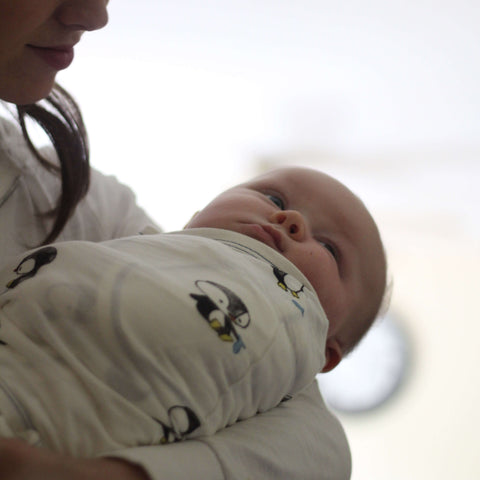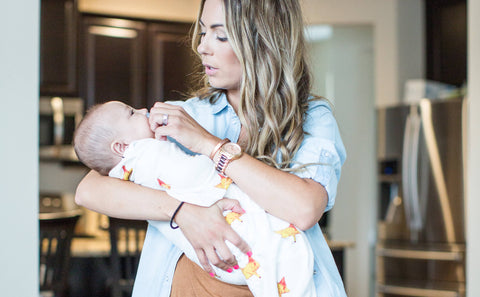Shopping Cart
While you are thrilled to be a new parent, it's totally normal to feel overwhelmed and exhausted. Trust me - I've been there! That's why I'm here to teach you how to get a newborn to sleep.
It isn't always easy getting your newborn baby to sleep (unless you are this dad.)
In reality, your baby is waking up every few hours and you've tried everything to get them to fall asleep...but nothing works.
A disrupted baby sleep schedule can quickly throw a wrench in your routine. Right now, you're just hoping for enough sleep to put together a coherent sentence or not snap at the most benign questions.
This article will help you learn your baby's sleep cues, avoid common sleep saboteurs and get your newborn to sleep. Here's a quick look at the 7 baby sleep tips to get your newborn to fall asleep at night:
1. Swaddle your baby
2. Avoid eye contact
3. Learn your baby's sleepiness cues
4. Develop a sleep routine
5. Change your diaper changing strategy
6. Don't try to "do it all"
7. Do what works
How to Get a Newborn to Sleep: 7 Tips for Parents Whose Newborn Won't Sleep
We're not going to waste any time as we've got a lot to cover today. Below, we'll empower you to be the best parent possible and teach you how to get a newborn to sleep with seven tips parents have used with great success.
Tip 1: Swaddling Your Baby
Ever heard of Moro Reflex? Its more common nickname is Startle Reflex, and it’s an infantile reflex that virtually all babies are born with.
You know that feeling you get, when you’re falling asleep in your desk chair, or halfway asleep in bed when suddenly, you feel like you’re free falling off a cliff and your body jolts awake. Yeah, that happens to babies too.
And unfortunately for you, it tends to happen a lot during nap and bed time, causing babies to flail their arms and legs and startle awake.
|
Baby Sleep Schedules Chart |
||||||
|
Baby's Age |
Number of Naps |
Nap Duration |
Daytime Sleep Hours |
Night Time Sleep Hours |
Night Time Hours in Stretch |
Total Sleep Hours Per Day |
|
Birth - 6 Weeks |
Varies |
30 mins - 4 hrs |
Varies |
Varies |
Possible 4 hrs |
14-17 hrs |
|
2 Months |
3-5 |
30 mins - 3 hrs |
7-9 hrs |
8-9 hrs |
Possibly 6 hrs |
14-17 hrs |
|
3 Months |
3-4 |
30 mins - 2 hrs |
4-8 hrs |
8-10 hrs |
6 hrs, sometimes |
14-16 hrs |
|
4 Months |
2-3 |
1-2 hrs |
3-6 hrs |
9-10 hrs |
6-8 hrs, sometimes |
12-16 hrs |
|
5-6 Months |
2-3 |
1-2 hrs |
3-4 hrs |
10-11 hrs |
10-11 hrs, sometimes |
12-16 hrs |
|
7-8 Months |
2 |
1-2 hrs |
3-4 hrs |
10-12 hrs |
10-12 hrs, maybe |
12-16 hrs |
|
9 Months |
2 |
1-2 hrs |
3-4 hrs |
10-12 hrs |
10-12 hrs, often |
12-16 hrs |
|
10-12 Months |
2 |
1-2 hrs |
3-4 hrs |
10-12 hrs |
10-12 hrs, usually |
12-16 hrs |
Moro reflex is present to protect your newborn in the early stages of development. It’s almost like an alarm that is triggered by any sudden changes in sensual stimulation (think: a loud noise, a sudden touch, or any event the puts the baby off balance – even being placed in a crib). The absence of Moro Reflex can indicate a problem in your baby’s nervous system.
There are so many benefits of swaddling - for one, it has been proven to significantly help calm babies when experiencing Moro Reflex. Swaddling keeps their arms and legs tucked close to their bodies, so they stay in place until the baby has calmed down. Not only does the Zen Swaddle keep your babies arms snug, it also provides the comforting pressure and security of a parent’s loving touch with the gently weighted pads on the chest and sides.

The great thing about the Zen Swaddle - and all our weighted sleepwear, for that matter - is that it not only keeps your baby from startling themselves awake at night, but it also provides that self-soothing simulated touch. So when you put your baby down at bedtime, they’ll still feel a snug embrace which will help them calm faster and stay asleep longer- which means a win for you and for baby.
READ MORE MOM SUCCESS STORIES HERE |
Swaddling also recreates the feeling of the womb for your baby (also helps if you've noticed the signs of sleep regression). Part of the reason babies sleep so much as newborns is because they’ve just spent 9 months mostly sleeping in the womb. Swaddling will simulate that warm, familiar place in a world that’s very overstimulating by comparison. Another reason to swaddle a baby? They will look like an adorable little burrito.
So, learn how to swaddle a baby in our blog. We have in-depth resources on swaddling techniques, types of swaddles, when to stop swaddling baby, what to do if newborn baby wants hands out of swaddle, and more. Then, choose from our zipper swaddle, arms up swaddle, bamboo swaddle, or weighted baby swaddle.
|
Zen Swaddle®: the perfect solution to sleeping through Moro Reflex. |
Tip 2: Avoid Eye Contact
The second tip in our guide on how to get a newborn to sleep might sound a little strange, but it's true. Prolonged or animated eye contact is actually very stimulating for babies, so it makes sense that you'd want to avoid this before bedtime and during night feedings and changes.
When you go to feed your baby in the middle of the night, it's important to keep them as calm and under-stimulated as possible. Although you might be doing all the right things when it comes to ambiance (keeping the room dark, using white noise, etc.) you also have to take into consideration your own actions and presence.
Pro Tip: Help your baby feel at rest by dressing them in comfortable clothing then settle them when you notice the first signs of sleepiness.
Just a short gaze or excitement in your voice can be a signal to your baby that it's playtime. Be sure that you're staying clam and low-key when you check on them at night. Avoid eye contact and speak to them in hushed tones so they know it's still time to sleep, not to play!
Tip 3: Learning Your Baby’s Sleepiness Cues
In the first 3 months, babies don't follow a set schedule for sleep. That is why we need to learn to read their tiredness signs, or "cues". By 3 - 4 months of age, a sleep pattern will emerge and you will get better at reading their cues.
At any age, you want to watch for over-tiredness. A common myth that the longer you keep them awake during the day, the better they sleep during the night. That’s like suggesting that if you starve them during the day they eat better at night. Unthinkable, right?
Sleep is just like that. In fact, babies that are overtired will take a lot longer to fall asleep. So keep watching for their tiredness cues. Here are some of these cues, some more subtle than others:
- Yawning: The easiest way to tell you baby is sleepy is if your baby yawns.
- Rubbing Eyes, Ear or Head: Consistently scratching the ear or rubbing the head or eyes is a common sign of sleepiness.
- Looking Away: Your baby may not hold your gaze and may look away.
- Jerkiness or Fussiness: An overtired baby also gets fussy. The cry may vary from a soft whimper to harsh shrill, depending on how tired the baby is. Listening for cues earlier in the process will help preventing them from getting to this dangerous point. Once crossed this point your baby may take a lot longer to sleep making it a painful experience for both you and him.
- Signs of Overtiredness: An overtired baby may cry a shrill cry. His arms may be stretched and body stiff while crying. Such a baby may be too hard to console or soothe.
How to Soothe an Overtired Baby
So what happens when you are unable to catch these cues? Or an unplanned event such as an ill-timed doctor's appointment, a visit to the store, or over stimulation disrupts your baby's nap schedule?
It is best to take an overtired baby to a quiet place, away from the environment that triggered the response. Even if you are away from the perfect ambiance of your nursery.
Trying to soothe your baby in a busy, stimulating atmosphere will only exacerbate their exhausted state. Rely on pacifiers or a security blanket if possible.
You may be tired as well. If possible, try giving your baby to a family member who is calmer than you. Your tiredness will rub off on the baby. If you are calm, they are calm.
Sleep Tip 4: Developing a consistent routine
Inconsistency is the number one cause of short naps and an erratic sleep routine. So now that you have learnt their signs of sleepiness, let’s see how we can develop a consistent routine.
I say a consistent routine, rather than a schedule, because "schedule" suggests having a set time, while "routine" suggests having consistent activities that lead to nap time which then develops a more predictable baby nap schedule.

Until about 6 weeks, your baby won’t have a set newborn bedtime routine. The fact is, they sleep so frequently that it’s almost obsolete. However, by as early as 4 to 6 weeks, you’ll notice a level of consistency emerge in his or her sleep pattern. Your baby's naps will consolidate into fewer but longer naps instead of the short bursts that your newborn would take. Regardless, it’s never too early to begin implementing some form of a routine – whether it’s swaddling, rocking, or shushing. Anything that can become your baby’s cue that it’s time to sleep.
THE 3 KEYS TO THE BEST BEDTIME ROUTINE...Calming activities: bathing, rocking, swaddling, etc. Consistency: keep the routine consistent and it will become your baby's "cue" that it's time to sleep! Simplicity: your routine should be easy to preform every night, in any environment. That way, even if you're not at home, you can recreate the routine to get your baby to relax. |
After your baby reaches the 6-week mark, it’s a great time to start implementing those good sleep habits. With a more predictable sleep and nap schedule, you can really hone in on that bedtime routine, which you probably tried to start during the newborn phase. Now, it will be a little easier to maintain.
Also keep in mind that your baby has and is continuing to undergo a lot of changes during this time – so something that might have helped soothe them to sleep a few weeks ago, might not do the trick anymore.
A soothing bedtime routine can include a warm bath, getting cleaned up (diaper change, soothing lotion, etc.), getting into jammies, cuddling, story time, swaddling, and a myriad of other things. As long as it’s an activity that’s calm and quiet, do whatever seems to work for your baby.
Watch the video below to hear an example of a simple bedtime routine from Zen Mom Brianna.
As you can see from Brianna's video, your routine doesn't need to be elaborate or complicated - it should just be whatever works for your baby. Most importantly, keep it consistent. Make this routine your nighttime ritual- even when you aren’t at home. Eventually, your baby will respond to the consistency and they’ll know when it’s time to sleep.
Just like the bedtime routine, the Zen Swaddle and Zen Sack work their magic better with more consistent use. By using the Zen Swaddle or Zen Sack as part of your bedtime routine, it will become one of your baby’s cues that it’s time to sleep, just like it has for Brianna and Noel! Plus, the gently weighted parts will help calm your baby easier before falling asleep.
A consistent sleep environment plays an important role in developing this routine and associated schedule as well.
To create a perfect environment, wind down activities as soon as you detect your baby’s sleepiness cues. Take the baby into his or her own room. Turn down the lights, draw the curtains, turn up the white noise, and swaddle before singing or shushing your baby to sleep. For one of the naps, the routine may also include bathing before nursing/feeding/suckling, swaddling, and shushing.
THE 3 KEYS TO CREATING A CALMING ENVIRONMENT...Make it Dark: You want to get your baby to associate nights with sleep, so keeping the room as dark as possible helps. The darkness will also prevent distraction and keep your baby calmer. Add White Noise: White noise helps mask other distracting noises in the environment around them. It also mimics the noises your baby was used to in the womb to help them relax. Take Note of the Temp: Temperature can have a surprisingly large impact on your baby's sleep. Too cold and they might wake up often, too hot and their risk of SIDS increases. Keeping the room at 68-72 degrees Fahrenheit is a good rule of thumb. |
I strongly recommend adding white noise to your baby's sleep environment as a positive sleep association.
What is White Noise?
Technically white noise is a sound produced by combining different frequencies with equal intensities together.
White noise may be technically produced and may sound like a hum, a drone, a radio station on static, a fan, washing machine or even the sound of rain among others.
Why do babies love white noise? Well they have spent 9 months in mother’s womb, a place not known to be quiet. In fact it is deafeningly loud in there.
What is sleep drive?
A consistent sleep routine helps build your drive to sleep (sleep drive or sleep pressure). Think about the last time you stayed up way too late finishing up work or binging your favorite Netflix show, then only ended up getting a few hours of sleep. That feeling you get when you’ve got to wake up in the morning when all you want to do is crawl back into bed – that’s sleep drive.
Your baby should have enough sleep drive that they nap very frequently in the first few weeks, staying away only 45 minutes to an hour and a half at a time. As your baby gets older and naps become fewer your baby needs enough sleep drive to get them to sleep for longer stretches of time.
An inconsistent sleep schedule can negatively affect your baby’s sleep drive, resulting in too short of naps and short stretches of sleep at night. Consistency will help regulate this!
Helping your baby sleep through mid-sleep arousal
Babies are also known to wake up mid sleep. You can lengthen the duration of their nap by simply helping them back to sleep by placing a hand on their chest or patting softly. Creating any other associations such as nursing is not advisable as these habits are very hard to break. However, we all need a little help sometimes.
Tip 5: Get Strategic About Diaper Changes
Did you know that many babies aren't bothered by sleeping with a wet diaper? Now, that doesn't mean you shouldn't be changing it throughout the night (especially if you're trying to treat a diaper rash), but it does mean you might be changing it more than you need to.
We keep mentioning the importance of keeping baby calm and activity low during nighttime. Diaper changes can be pretty active and can really wake your baby up. Start changing your baby's diaper before you feed them, that way they can calm back down and hopefully fall asleep either while your feeding them, or shortly after.

By changing their diaper after a feeding, you might think you're increasing the amount of time in between the next diaper change - but really you're just making them more alert right before expecting them to fall back asleep.
If you have to change their diaper after being fed, don't turn on the lights, avoid talking to them excitedly and making eye contact. Try to master the diaper change with just the light from a night light so you're not giving your baby any signals that it's time to wake up.
Tip 6: Don't Try to "Do it All"
Moms always want to do it all - it's part of our nature. But when you've just had a baby, "doing it all" is more exhausting than it normally is...and somewhat impossible. This tip is mainly to help you get the rest you need (and deserve!) but is also a reminder that your attitude and exhaustion can rub off on your baby.
If you're cranky and tired and you're trying to soothe your baby to sleep, they're going to pick up on that. That's why it's sometimes a good idea to pass the baby off to someone a little calmer and more relaxed when trying to get your baby to sleep. If you are calm, your baby will calm easier as well.
Since stretching yourself too thin doesn't do any good for you or your baby, don't feel like everything is up to you! Ask a friend or family member to babysit for a few hours so you can go take a nap or get out of the house.

If you don't feel comfortable handing off any newborn duties quite yet, let go of some of the other things on your plate and delegate them out. The laundry, vacuuming, cooking, walking the dog...these are all things you can either ask a friend or family member for help with or hire someone to do for you. While you might not normally spend money on these types of services, with a new baby at home it will save you time and your sanity.
Friends and family are always looking for ways to help new moms. So tell them what you REALLY need when they offer.
If you don't have any friends or relatives to rely on, consider hiring a cleaning service, bringing laundry to the dry cleaners, or paying for a meal service that will make preparing dinner a breeze!
You can even check out sites like taskrabbit.com where you can find people (carefully vetted, of course) willing to clean your house, do your grocery shopping, and mow your lawn for pretty cheap. Once these mundane chores fall of your list, you'll feel less stressed and, more importantly, will have more time to spend bonding with and caring for your baby...and getting some rest!
Tip 7: Do What Works
There's one more piece of advice we want to offer in this guide on how to get a newborn to sleep: do what works. Help can come in many forms. Perhaps it’s your partner taking some night shifts, a family member or friend coming over during the day so you can get some long hours of uninterrupted sleep, or it could be using a sleep aid- like a white noise machine, swing, pacifier, etc.
Moms might be wary to try any of these with fears of developing sleep associations or becoming dependent upon those aids. But let’s get real: sleep (for you and your newborn!) is a priority. If you can avoid using a sleep aid with your baby, that’s great! But these products exist for a reason, so don’t beat yourself up for using them. If it works, let it.
Even lead sleep coach and President of The Baby Sleep Site, Nicole Johnson, says in the first six to eight weeks, you do what you have to do:
FROM THE EXPERTS“In an ideal world, we wouldn’t use ‘sleep crutches’ but every stage a baby goes through a parent needs to use different tools from their toolbox, whether it’s a swaddle, white noise machine, swing (approved for safe sleep), a pacifier, etc. That doesn’t mean your baby will need these aids forever or that you won’t need to transition away from them later, but in the newborn days sanity is the priority and the most important thing you do with your newborn is bond and part of that is making sure their basic needs are met.” - Nicole Johnson, The Baby Sleep Site |
The Zen Swaddle has been known to be a huge helper for parents with little ones that won’t sleep unless they’re being held or touched. So when the pacifier, the swing, or the white noise machine just isn’t doing the trick for your little one – we’ve got you covered because we aren’t just your average swaddle. Because of its gently weighted parts, babies can actually self-soothe.
READ MORE MOM SUCCESS STORIES HERE |
So, when you find yourself in need of a “sleep crutch”, feel free to lean on us! Learn more about how our Zen Swaddle works here.
And when all else fails, you can always give the “tissue trick” a try!
Bringing Our Conversation on How to Get a Newborn to Sleep to a Close
There you have it - how to get a newborn to sleep. Hopefully, this guide has eased a bit of your stress and helps you improve your newborn sleep routine - thus, getting you the much-needed sleep you deserve as well!
While navigating the tumultuous period of newborn baby sleep routines can be frustrating, these newborn sleep tips will help you find calm in the chaos. You can learn more in our blog about how to help a teething baby sleep in particular, or how to dress newborn for sleep. We also have guides on sleep training baby, like the Fading method sleep training or Ferber method sleep training.
But ultimately, there's just one thing left to do. Now that you've read our guide on how to get a newborn to sleep, it's time to put these newborn sleep tips to the test. Best of luck - and remember to enjoy this stage, as challenging and frustrating as it may be. Your child will be sleeping in their own big kid bed before you know it!






My little one likes to be swaddled but the other sleep sacks are to short, I’ve had to go to swaddle blankets that she gets her arms out of easier. I’m excited to get yours not only due to the other benefits but also because is supposed to fit up to 28".
Amanda on
This is an excellent article!
I’m a mama of soon to be #10 and can vouch that all of the above is fantastic advice. …And of course your product is genius!
The “tissue trick” doesn’t have to be done with a tissue. I use my finger tips and gently caress the forehead down over the face, of course they need to be ready for sleep, either displaying sleepy cues or time for regular (consistent is key) nap/sleep time.
Additionally if baby is having minor issues with digestion, as most experience some at first, being a new way of eating for them, drinking a cup of chamomile tea before bedtime almost always helps.
And not to sound trite but make sure you, the mama, is taking care of yourself! If you begin to have deficiencies in minerals and vitamins, the baby will not be as content if breastfeeding. Nor will you. And like the article states, “if you are calm, they are calm”.
LOVE this article, we need more mama encouragement!
Emily on
Zen swaddle is my favorite.
Krystal Tyree on
I love swaddling but my little is now a tummy sleeper at 4 months. I’m excited to try the Zen sleep sack premiere (if I win it)!! Friendly Fox is my favorite print!!
Amy on
I love the style of the gray zen sack! I hope to receive one soon and see if it helps my little one rest comfortably!
Kelli Mcquesten on